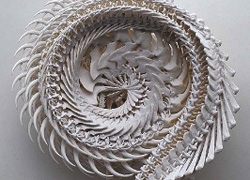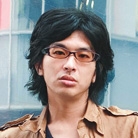A return to sculpture, and new departure for the future
Text: Uchida Shinichi
Portrait: Nagare Satoshi
Since appearing on the scene as one of a new generation of artists with sculptural roots, Odani Motohiko has continued to create works of monstrous beauty that excite painful sensations in the viewer. This year, a decade after his debut, this artist also renowned for the sheer diversity of his work, which encompasses video and photography as well as three-dimensional forms, will once again begin to channel his energies seriously into sculpture.
 SP2 New Born, 2007, Courtesy Yamamoto Gendai
SP2 New Born, 2007, Courtesy Yamamoto Gendai
“Looking back,” Odani says, “I think that having been churning out sculpture like there was no tomorrow, I eventually found myself in a dilemma over the number of resources I actually had to draw on within myself and the direction my output was taking, and as familiarity began to breed contempt with sculpture, I backed off a little and incorporated various other media. At some level though I’ve always felt a need to return to sculpture, and for the past three years I’ve been sharpening up my act again in readiness, both technically and mentally.”
The new sculptures exhibited at this summer’s SP2 New Born, Odani’s first solo show in three years, while on the one hand resembling fossil specimens from some otherworldly creature, with their swirling spirals and soaring dragon-like designs can also be seen as an expression of the artist’s powerful intent. A disquieting dynamism born out of prodigious precision. At this opening of a new chapter in his artistic development, Odani was drawn to Italian Futurist painter and sculptor Umberto Boccioni’s view of sculpture.
“Right now I have this strong Futurist interest in how to capture the concepts of movement and transformation, dynamism and speed in sculpture. I can really relate to Boccioni’s assertion that modern sculpture was a ‘dead art’, and his concern with regenerating it. Although in my case we’re talking about taking a fresh look at the history of sculpture in Japan. I’m not sure if calling it slow to evolve is quite the right phrase, but I do sense a lack of historical continuity and attempts at comparison. I’d like to head somewhere different to that, in the shortest possible distance.”
Boccioni et al.’s “Technical Manifesto of Futurist Painting” stated that “The gesture which we would reproduce on canvas shall no longer be a fixed moment in universal dynamism. It shall simply be the dynamic sensation itself.” But can a world changing at a speed to paralyze the senses engender such expression? The present and future Odani sees now encompass a different set of hopes and uncertainties to those of artists at the beginning of the 20th century. Will the spirals he carves rise to become the nucleus of sculptural expression, and will he strike out boldly from that nucleus? It will be worth watching to find out.
Odani notes, “Some of the works I’ll be presenting from here on people will find easy to relate to; others will be too understated for most tastes (laughs). But I’ll make them all, because every one will be essential to the overall picture of my project. I used to find that idea of an everchanging, impalpable style appealing, but now I want to concentrate on the things I ought to be doing, the things only I can do. The result I hope will be works that like the Buddhist statues of the past will be capable of communicating with people for centuries to come.”
Originally printed in ART iT 17 Fall/Winter 2007
ART iT 18 features an in-depth interview with the artist.

Odani Motohiko
Born 1972 in Kyoto. BFA in sculpture and MFA from Tokyo National University of Fine Arts and Music. Best known for his visions of the future premised on ‘mutation’ and ‘transformation’ of the body in sculpture, film and photography.
